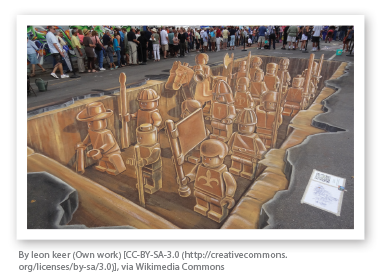412
Creating Visual Structure
Some creations are experienced all at once. Visual art—a painting, poster, sculpture, photograph, or drawing—often evokes immediate, powerful reactions. Such structures have common visual elements that work together to create this appeal.

- Focus is the main subject of the visual. Find it by observing the work in its full context (see pages 220–221).
- Figures are the people, objects, or things included in the visual.
- Value, being light or dark, offers the contrast that creates perspective. Light objects appear closer than dark objects.
- Color creates a mood. Contrasts in color convey energy and emotion.
- Space, the area occupied by the figures or existing between the figures, creates depth and perspective. Artists and photographers use a number of techniques to make a flat image look three-dimensional.
- Overlap makes figures in front appear closer than those behind.
- Diminishing size makes larger figures appear closer than smaller ones.
- Vertical position makes lower figures appear closer than higher ones.
- Linear perspective follows converging lines to a vanishing point.
- Atmospheric perspective makes sharper figures look closer than hazy figures.
- Proportion describes a figure’s size relative to its surroundings.
- Perspective is the way the work appears to the viewer. Point of view and angle affect the viewer’s understanding. For the photo above, the photographer stands at the perfect angle to see the street painting. Those behind the painting have a completely distorted image to look at.
- Emphasis is the focal point of the work, the area that first attracts the viewer’s attention.
Also consider typography in written work (see page 226). For more information about the elements of visual structure, see page 222.
Your Turn Analyze the visual elements in a favorite piece of art (painting, photograph, drawing, and so on). Comment on each of the elements listed above. How do these elements affect the work’s overall impact?

